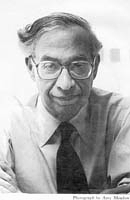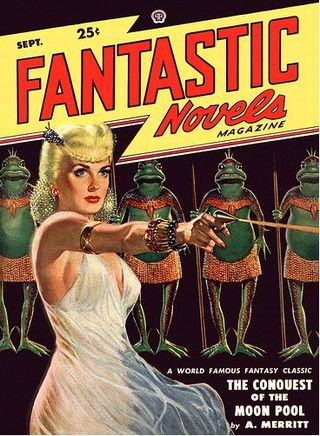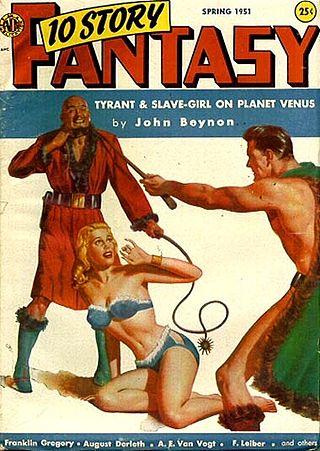
Donald Allen Wollheim was an American science fiction editor, publisher, writer, and fan. As an author, he published under his own name as well as under pseudonyms, including David Grinnell, Martin Pearson, and Darrell G. Raynor.

The Magazine of Fantasy & Science Fiction is a U.S. fantasy and science-fiction magazine first published in 1949 by Mystery House, a subsidiary of Lawrence Spivak's Mercury Press. Editors Anthony Boucher and J. Francis McComas had approached Spivak in the mid-1940s about creating a fantasy companion to Spivak's existing mystery title, Ellery Queen's Mystery Magazine. The first issue was titled The Magazine of Fantasy, but the decision was quickly made to include science fiction as well as fantasy, and the title was changed correspondingly with the second issue. F&SF was quite different in presentation from the existing science-fiction magazines of the day, most of which were in pulp format: it had no interior illustrations, no letter column, and text in a single-column format, which in the opinion of science-fiction historian Mike Ashley "set F&SF apart, giving it the air and authority of a superior magazine".

Unknown was an American pulp fantasy fiction magazine, published from 1939 to 1943 by Street & Smith, and edited by John W. Campbell. Unknown was a companion to Street & Smith's science fiction pulp, Astounding Science Fiction, which was also edited by Campbell at the time; many authors and illustrators contributed to both magazines. The leading fantasy magazine in the 1930s was Weird Tales, which focused on shock and horror. Campbell wanted to publish a fantasy magazine with more finesse and humor than Weird Tales, and put his plans into action when Eric Frank Russell sent him the manuscript of his novel Sinister Barrier, about aliens who own the human race. Unknown's first issue appeared in March 1939; in addition to Sinister Barrier, it included H. L. Gold's "Trouble With Water", a humorous fantasy about a New Yorker who meets a water gnome. Gold's story was the first of many in Unknown to combine commonplace reality with the fantastic.

Other Worlds, Universe Science Fiction, and Science Stories were three related US magazines edited by Raymond A. Palmer. Other Worlds was launched in November 1949 by Palmer's Clark Publications and lasted for four years in its first run, with well-received stories such as "Enchanted Village" by A. E. van Vogt and "Way in the Middle of the Air", one of Ray Bradbury's "Martian Chronicle" stories. Since Palmer was both publisher and editor, he was free to follow his own editorial policy, and presented a wide array of science fiction.

Oriental Stories, later retitled The Magic Carpet Magazine, was an American pulp magazine published by Popular Fiction Co., and edited by Farnsworth Wright. It was launched in 1930 under the title Oriental Stories as a companion to Popular Fiction's Weird Tales, and carried stories with far eastern settings, including some fantasy. Contributors included Robert E. Howard, Frank Owen, and E. Hoffman Price. The magazine was not successful, and in 1932 publication was paused after the Summer issue.
Uncanny Tales was a Canadian science fiction pulp magazine edited by Melvin R. Colby that ran from November 1940 to September 1943. It was created in response to the wartime reduction of imports on British and American science-fiction pulp magazines. Initially it contained stories only from Canadian authors, with much of its contents supplied by Thomas P. Kelley, but within a few issues Colby began to obtain reprint rights to American stories from Donald A. Wollheim and Sam Moskowitz. Paper shortages eventually forced the magazine to shut down, and it is now extremely rare.

Science Fiction Quarterly was an American pulp science fiction magazine that was published from 1940 to 1943 and again from 1951 to 1958. Charles Hornig served as editor for the first two issues; Robert A. W. Lowndes edited the remainder. Science Fiction Quarterly was launched by publisher Louis Silberkleit during a boom in science fiction magazines at the end of the 1930s. Silberkleit launched two other science fiction titles at about the same time: all three ceased publication before the end of World War II, falling prey to slow sales and paper shortages. In 1950 and 1951, as the market improved, Silberkleit relaunched Future Fiction and Science Fiction Quarterly. By the time Science Fiction Quarterly ceased publication in 1958, it was the last surviving science fiction pulp magazine, all other survivors having changed to different formats.

Amazing Stories Annual was a pulp magazine which published a single issue in July 1927. It was edited by Hugo Gernsback, and featured the first publication of The Master Mind of Mars, by Edgar Rice Burroughs, which had been rejected by several other magazines, perhaps because the plot included a satire on religious fundamentalism. The other stories in Amazing Stories Annual were reprints, including two stories by A. Merritt, and one by H.G. Wells. The magazine sold out, and its success led Gernsback to launch Amazing Stories Quarterly the following year.

Science Fiction Adventures was an American digest-size science fiction magazine, published from 1956 to 1958 by Irwin Stein's Royal Publications as a companion to Infinity Science Fiction, which had been launched in 1955. Larry Shaw was the editor for all 12 issues. Science Fiction Adventures focused on longer fiction than appeared in Infinity; these were often labelled as novels, though they were rarely longer than 20,000 words. Shaw declared in his first editorial that he wanted to bring back a "sense of wonder", and he printed straightforward action-adventure stories. Two other magazines of the period, Imagination and Imaginative Tales, had similar editorial approaches, but science fiction historian Mike Ashley considers that Science Fiction Adventures' fiction was the best of the three. Robert Silverberg was a prolific contributor, under his own name and under the pseudonym "Calvin M. Knox", and he also collaborated with Randall Garrett on two stories in the first issue, under two different pseudonyms. Other well-known writers occasionally appeared, including Harlan Ellison, Cyril M. Kornbluth, Algis Budrys, and Harry Harrison. Ed Emshwiller contributed cover art for nine of the twelve issues, and one of the other three was among John Schoenherr's earliest sales.
Science Fiction Adventures was a British digest-size science fiction magazine, published from 1958 to 1963 by Nova Publications as a companion to New Worlds and Science Fantasy. It was edited by John Carnell. Science Fiction Adventures began as a reprint of the American magazine of the same name, Science Fiction Adventures, but after only three issues the American version ceased publication. Instead of closing down the British version, which had growing circulation, Nova decided to continue publishing it with new material. The fifth issue was the last which contained stories reprinted from the American magazine, though Carnell did occasionally reprint stories thereafter from other sources.

Fantastic Novels was an American science fiction and fantasy pulp magazine published by the Munsey Company of New York from 1940 to 1941, and again by Popular Publications, also of New York, from 1948 to 1951. It was a companion to Famous Fantastic Mysteries. Like that magazine, it mostly reprinted science fiction and fantasy classics from earlier decades, such as novels by A. Merritt, George Allan England, and Victor Rousseau, though it occasionally published reprints of more recent work, such as Earth's Last Citadel, by Henry Kuttner and C. L. Moore.

A. Merritt's Fantasy Magazine was an American pulp magazine which published five issues from December 1949 to October 1950. It took its name from fantasy writer A. Merritt, who had died in 1943, and it aimed to capitalize on Merritt's popularity. It was published by Popular Publications, alternating months with Fantastic Novels, another title of theirs. It may have been edited by Mary Gnaedinger, who also edited Fantastic Novels and Famous Fantastic Mysteries. It was a companion to Famous Fantastic Mysteries, and like that magazine mostly reprinted science-fiction and fantasy classics from earlier decades.

Comet was a pulp magazine which published five issues from December 1940 to July 1941. It was edited by F. Orlin Tremaine, who had edited Astounding Stories, one of the leaders of the science fiction magazine field, for several years in the mid-1930s. Tremaine paid one cent per word, which was higher than some of the competing magazines, but the publisher, H-K Publications based in Springfield, MA, was unable to sustain the magazine while it gained circulation, and it was cancelled after less than a year when Tremaine resigned. Comet published fiction by several well-known and popular writers, including E.E. Smith and Robert Moore Williams. The young Isaac Asimov, visiting Tremaine in Comet's offices, was alarmed when Tremaine asserted that anyone who gave stories to competing magazines for no pay should be blacklisted; Asimov promptly insisted that Donald Wollheim, to whom he had given a free story, should make him a token payment so he could say he had been paid.

Dynamic Science Stories was an American pulp magazine which published two issues, dated February and April 1939. A companion to Marvel Science Stories, it was edited by Robert O. Erisman and published by Western Fiction Publishing. Among the better known authors who appeared in its pages were L. Sprague de Camp and Manly Wade Wellman.

Out of This World Adventures was an American pulp magazine which published two issues, in July and December 1950. It included several pages of comics as well as science fiction stories. It was edited by Donald A. Wollheim and published by Avon. Sales were weak, and after two issues Avon decided to cancel it.

10 Story Fantasy was a science fiction and fantasy pulp magazine which was launched in 1951. The market for pulp magazines was already declining by that time, and the magazine only lasted a single issue. The stories were of generally good quality, and included work by many well-known writers, such as John Wyndham, A.E. van Vogt and Fritz Leiber. The most famous story it published was Arthur C. Clarke's "Sentinel from Eternity", which later became part of the basis of the movie 2001: A Space Odyssey.

Flash Gordon Strange Adventure Magazine was a pulp magazine which was launched in December 1936. It was published by Harold Hersey, and was an attempt to cash in on the growing comics boom, and the popularity of the Flash Gordon comic strip in particular. The magazine contained a novel about Flash Gordon and three unrelated stories; there were also eight full-page color illustrations. The quality of both the artwork and the fiction was low, and the magazine only saw a single issue. It is now extremely rare.

Science-fiction and fantasy magazines began to be published in the United States in the 1920s. Stories with science-fiction themes had been appearing for decades in pulp magazines such as Argosy, but there were no magazines that specialized in a single genre until 1915, when Street & Smith, one of the major pulp publishers, brought out Detective Story Magazine. The first magazine to focus solely on fantasy and horror was Weird Tales, which was launched in 1923, and established itself as the leading weird fiction magazine over the next two decades; writers such as H.P. Lovecraft, Clark Ashton Smith and Robert E. Howard became regular contributors. In 1926 Weird Tales was joined by Amazing Stories, published by Hugo Gernsback; Amazing printed only science fiction, and no fantasy. Gernsback included a letter column in Amazing Stories, and this led to the creation of organized science-fiction fandom, as fans contacted each other using the addresses published with the letters. Gernsback wanted the fiction he printed to be scientifically accurate, and educational, as well as entertaining, but found it difficult to obtain stories that met his goals; he printed "The Moon Pool" by Abraham Merritt in 1927, despite it being completely unscientific. Gernsback lost control of Amazing Stories in 1929, but quickly started several new magazines. Wonder Stories, one of Gernsback's titles, was edited by David Lasser, who worked to improve the quality of the fiction he received. Another early competitor was Astounding Stories of Super-Science, which appeared in 1930, edited by Harry Bates, but Bates printed only the most basic adventure stories with minimal scientific content, and little of the material from his era is now remembered.

Ace Mystery was a weird menace pulp magazine which published three issues starting 1936, followed by two more under the title Detective Romances. It was published by Periodical House and edited by Harry Widmer. Writers who appeared in the magazine included Frederick C. Davis, who wrote all three lead novels, Hugh B. Cave, and Robert C. Blackmon; magazine historian Michael Cook comments that these were capable writers, but the rest of the magazine was too low-quality to succeed. Some of the stories were fantasy rather than weird menace -- for example, one story was about a sculptor who could shrink dead bodies. Science fiction historian Mike Ashley is more positive than Cook, describing the magazine as "of reasonably good quality", and singling out Charles Marquis Warren's "Coyote Woman" for praise; Ashley quotes pulp historian Robert K. Jones, who considered the "Coyote Woman" "...among the most effective vampire stories to appear in the pulps".
Between 1965 and 1976, Sol Cohen published over a hundred issues of science fiction magazines under a set of related titles.


















